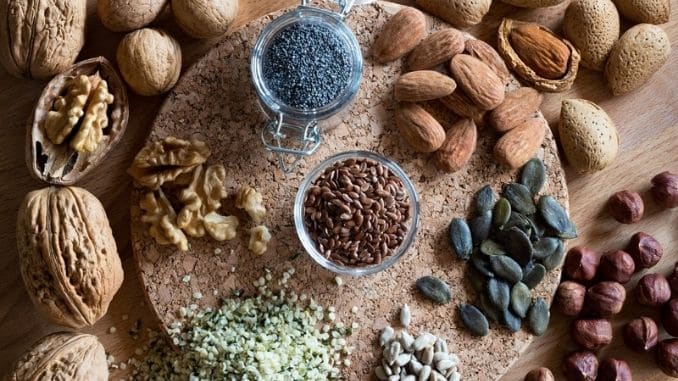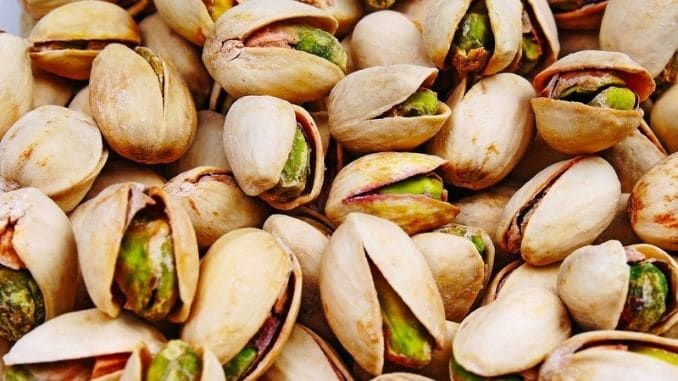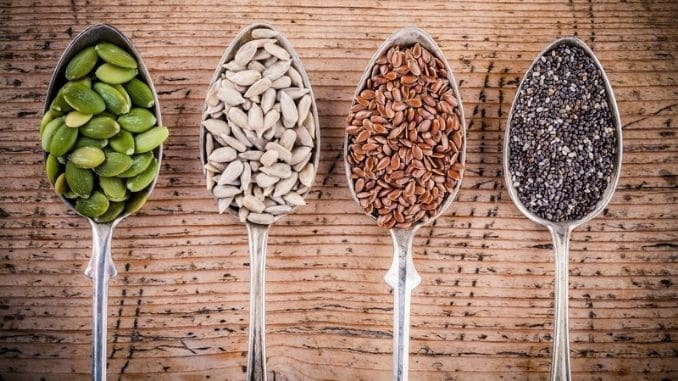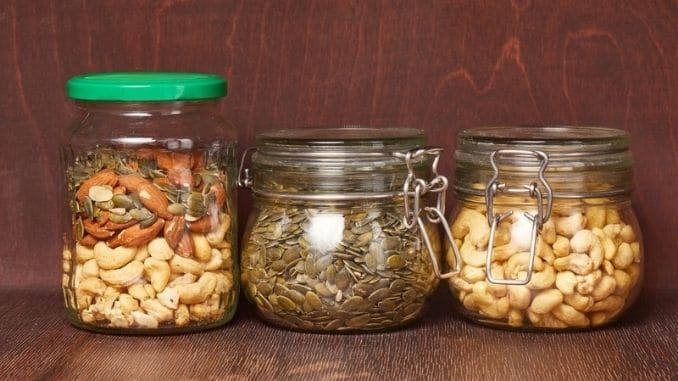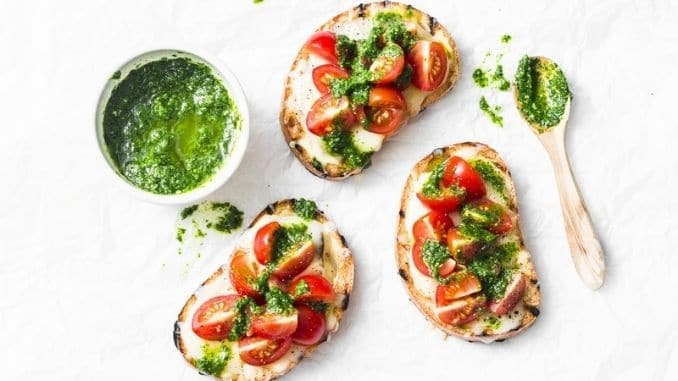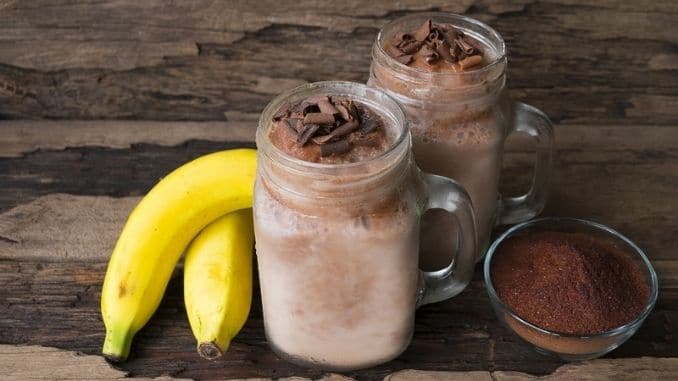
Nuts and seeds are among the smallest food sources in the human diet. However, in these tiny bits of nourishment, huge benefits can be found. We’ve done some research on nuts and seeds to provide every little thing you might need to know about them. We’ve also created a few recipes to help you incorporate more nuts and seeds into your diet.
Nuts
A nut is generally defined as a hard-shelled dry fruit with a woody outer rind. A few decades ago, before we had a good understanding of the benefits of good fats, most dieters and health-conscious eaters ate nuts sparingly to avoid their high-fat content. However, researchers and nutritionists have since uncovered that nuts contain monounsaturated and polyunsaturated fats ― which are shown to lower the body’s LDL (or bad) cholesterol. The unsaturated fats have also been proven to have anti-inflammatory properties.
The Health Benefits of Eating Nuts
Nuts are an excellent dietary staple for many reasons. However, which types of nuts are the best? Should we eat raw or roasted nuts? Where’s the best place to buy fresh nuts? Which nuts should be avoided, and do we really have to soak them before we eat them? Read on to find answers to all your nutty questions and everything you need to know about nuts.
The Better Nuts
While all nuts provide some nutrition, there are a few nut varieties that are more superior than others, in terms of nutrients provided. Here are some of the nuts that we found to be best for dietary consumption.
Walnuts
Walnuts are beneficial to the body because they’re high in the essential omega-3 fatty acid called alpha-linolenic acid (ALA). ALA decreases inflammation in the body and can boost cardiovascular health. Walnuts are also very high in antioxidants.
Almonds
Just one serving of almonds awards the body with nearly half of the recommended daily amount of vitamin E. Researchers have also found that when consumed alongside foods with a high glycemic index, almonds lower the rise in blood sugar after eating. Thus, lowering the risk of developing type 2 diabetes.
Brazil Nuts
Grown in trees native to South America, Brazil nuts are the richest dietary source of selenium around. Eating just a few of these large nuts daily has been shown more effective than taking selenium supplements. Selenium has been shown to prevent depression, fight cancer and boost reproductive health.
Pistachios
Pistachios are high in fiber. Eating pistachios may also help raise the body’s HDL (good) cholesterol. Research has found that pistachios, like almonds, also lower the glycemic load of foods consumed with them.
Peanuts
We know – peanuts aren’t technically nuts. They are actually legumes. However, we’re going to include them in the nut category anyway. One of the reasons peanuts are so healthy for us is that they contain resveratrol, the phytochemical that’s also found in red wine and protects against heart disease. Peanuts are also high in antioxidants. According to George Mateljan at The World’s Healthiest Foods, a serving of peanuts has more antioxidants than a serving of apples, beets or carrots.
Pecans
The Center for Agroforestry states, “Pecans contain 19 vitamins and minerals, including vitamin A, magnesium, potassium, B complex vitamins and phosphorous.” Pecans are also high in phytosterols ― the plant chemicals that protect humans from cardiovascular disease.
Hazelnuts
Consuming hazelnuts may lower your risk of heart disease. Researchers have found that hazelnuts contain several B vitamins that can reduce the risk of both heart disease and stroke. Hazelnuts also have a good amount of minerals like magnesium, calcium, and potassium that may lower blood pressure.
Should We Eat Raw or Roasted Nuts?
Nuts are often roasted to intensify their flavor, improve their consistency and add crunchiness. By and large, a nut’s nutrition doesn’t change much during a light roasting. Roasting at unusually high temperatures or for extended periods of time can deplete certain nutrients. However, normal roasting is fine and may make the nuts easier to digest.
Where Can I Find the Freshest Nuts?
If your community has a farmers’ market or a local nut farm, you’ll find the freshest nuts there. Otherwise, if your only option is the grocery store, look for stores that sell out of their stock often. That way, you can be sure you’re getting nuts from the most recent delivery ― rather than nuts that might have sat on the shelf for nine months.
Is It Best to Soak Nuts Before Eating Them?
Among nutritionists and foodies, it’s recommended to soak your nuts in saltwater overnight and dry them completely ― about 12 hours in a food dehydrator ― before consumption. Soaking and dehydrating them neutralizes the phytic acid and enzyme inhibitors naturally occurring in nuts. Phytic acid can make it difficult for the body to absorb nutrients from nuts and digest them properly.
While soaking and dehydrating nuts may be the best way to enjoy them, not all of us have an extra 19 hours to prep a handful of nuts before consumption. In addition, not everyone absolutely needs to soak their nuts. Kayla Grossmann came up with four questions you should ask yourself to determine if soaking and dehydrating nuts are necessary for your particular needs.
- Do you ever experience low belly pain after eating nuts, seeds or foods that contain them?
- Do you ever notice pieces of nuts in your stool the day after eating them?
- Do you eat a significant amount of phytate-containing foods, such as grains, beans, nuts, and seeds?
- Do you struggle to consume enough minerals and B vitamins in your diet?
If you answered yes to any of the questions above, then you may want to consider taking the time to soak and dehydrate your nuts before you eat them. Otherwise, your body is likely handling the phytate-containing foods in your diet without a problem. Soaking your nuts may still be a good idea if you have the time and interest. However, if you don’t experience digestion issues after eating nuts, it may not be necessary.
Seeds
Wouldn’t it be nice if there were some tiny nutrients that we could incorporate into a variety of recipes without changing the taste or consistency much? Good news ― seeds are packed full of rich nutrients, and many of them can be added to baked goods, granolas, smoothies, oatmeal, and breadcrumbs to boost the vitamin, mineral and fiber content of these dishes.
By definition, a seed is the ripened ovule of a plant. It’s a flowering plant’s unit of reproduction, capable of developing into another such plant. Some of the most common edible seeds used today are flaxseeds, chia seeds, poppy seeds, pumpkin seeds, and wild rice ― yes, it’s a grass seed, not a grain ― pomegranate seeds, quinoa, sesame seeds, sunflower seeds and hemp seeds.
The Best Seeds
While most seeds provide a hefty helping of protein, fiber, minerals, vitamins, and essential fats, some seeds stand out as the most nutritious. Here are some of the seeds we found to be incredibly beneficial.
Chia Seeds
The same tiny black specks that brought us so much fun in the 1970s and 1980s, “ch-ch-ch-chia” seeds are loaded with goodness. In a two-tablespoon serving of chia seeds, you’ll find 10 grams of fiber, plenty of protein, antioxidants, iron, magnesium, calcium, zinc, and omega-3 fatty acids.
Hemp Seeds
Need to add 10 grams of protein, some omega-3 fatty acids, amino acids and fiber to your life? Try a serving ― 2 tablespoons ― of hemp seeds. Hemp protein is one of the easiest types of proteins for our human bodies to use and digest.
Flaxseeds
Flaxseeds are incredibly healthy, but they must be ground for the body to use them effectively. They are rich in omega-3 ALA, and they also contain fiber and magnesium. Studies show that adding flaxseeds to the diet can improve cardiovascular health and reduce inflammation.
Pumpkin Seeds
Pumpkin seeds are an excellent source of magnesium. They’re also loaded with iron, fiber, amino acids, zinc, and omega-3 fatty acids. They’re tasty as a salad topping or just a healthy snack.
What’s the Best Way to Store Nuts and Seeds?
Because nuts and seeds contain a fairly high amount of healthy, unsaturated oils, they can go rancid relatively quickly. Proper storage of nuts and seeds can safely extend their shelf life.
In the nut family, pine nuts and pistachios have the shortest shelf life. Pine nuts may only last about a month on your pantry shelf. Pistachios can last up to three months stored at room temperature. However, in the freezer, you can expect pine nuts or pistachios to last around six months without going rancid. Most other nuts, like walnuts, almonds, and peanuts can stay freshly refrigerated, in airtight containers, for up to a year ― even longer in the freezer.
Regardless of whether you are storing your nuts and seeds for the short-term, at room temperature or in the freezer for a year, it’s imperative that you keep the nuts in a sealed, airtight container. We recommend large, glass Mason jars for optimal storage.
Recipes With Nuts and Seeds
Here are just a few healthy and delicious recipes using nuts and seeds. Please leave a comment if you try them.
Walnut Avocado Pesto
INGREDIENTS
- 1/4 cup walnuts
- 1 avocado
- 1 bunch basil
- 3 cloves garlic
- Juice from 1/2 lemon
- 2 tablespoons extra virgin olive oil
- Salt, to taste
DIRECTIONS
Blend all the ingredients in a food processor. Serve over pasta, with salad or over vegetables.
Basic Hummus
INGREDIENTS
- 1 can (15 ounces) chickpeas, drained
- 3 cloves garlic
- 2 tablespoons tahini
- 2 tablespoons extra virgin olive oil
- Juice from 1/2 lemon
- 1/2 teaspoon cumin
DIRECTIONS
Blend all of the ingredients in a food processor. Serve with cut vegetables as a dip.
Seedy Chocolate Shake
INGREDIENTS
- 4 peeled, frozen bananas
- 2 cups almond milk
- 2 tablespoons unsweetened cocoa
- 1 teaspoon coconut oil
- Pinch of salt
DIRECTIONS
Blend all ingredients in a blender and serve.
Nuts and Seeds
An excellent way to add minerals, essential fats, amino acids, protein and fiber to your diet is to enjoy several servings of nuts and seeds each day.
What we eat is essential for our health and wellbeing. For your guide to the best foods to heal your body, check out The Best Foods that Rapidly Slim & Heal in 7 Days, here!
References:
Grossmann, K. (n.d.). That’s nuts! A complete guide to soaking nuts and seeds. Retrieved from: https://blog.radiantlifecatalog.com/bid/69542/That-s-Nuts-A-Complete-Guide-to-Soaking-Nuts-and-Seeds
Hemmelgarn, M. (n.d.). Why pecans? Retrieved from: http://www.centerforagroforestry. org/pubs/whypecans.pdf
Metaljan, G. (2018). Almonds. Retrieved from: http://www.whfoods. com/genpage.php?tname=foodspice&dbid=20
Noxon, B. (n.d.). The nut case: do they have too much fat? Retrieved from: https://www.active.com/nutrition/articles/the-nut-case-do-they-have-too-much-fat
Nut. 2018. In Merriam-Webster.com. Retrieved from: https://www.merriam-webster.com/dictionary/nut
Prakash, S. (2014). How to store nuts and seeds. Retrieved from: https://food52.com/blog/11275-how-to-store-nuts-and-seeds
Seed. (2018). In Merriam-Webster.com. Retrieved from: https://www.merriam-webster.com/dictionary/seed
Simon, A. (2016). 11 seeds you should be eating. Retrieved from: https://www.onhealth.com/content/1/high_fiber_heart_healthy_diet

